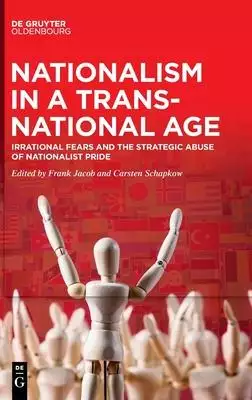how to determine fre的問題,透過圖書和論文來找解法和答案更準確安心。 我們找到下列包括價格和評價等資訊懶人包
how to determine fre的問題,我們搜遍了碩博士論文和台灣出版的書籍,推薦寫的 Re-Understanding Media: Feminist Extensions of Marshall McLuhan 和的 Nationalism in a Transnational Age: Irrational Fears and the Strategic Abuse of Nationalist Pride都 可以從中找到所需的評價。
這兩本書分別來自 和所出版 。
國立清華大學 資訊工程學系 李政崑所指導 張元銘的 人工智慧和開放計算語言的執行時系統和框架支持 (2020),提出how to determine fre關鍵因素是什麼,來自於異構系統架構、開放計算語言、執行時系統、便攜式計算語言、圖形處理器、開放式神經網路格式、交換式神經網路格式、神經網路應用接口。
而第二篇論文國防醫學院 生命科學研究所 趙裕展所指導 蔡智瑄的 以結構導向重組提高流感病毒血球凝集素之穩定性 (2019),提出因為有 桿狀病毒、血球凝集素、流感病毒、SCHEMA、結構導向重組、熱穩定性的重點而找出了 how to determine fre的解答。
除了how to determine fre,大家也想知道這些:
Re-Understanding Media: Feminist Extensions of Marshall McLuhan

為了解決how to determine fre 的問題,作者 這樣論述:
The contributors to Re-Understanding Media advance a feminist version of Marshall McLuhan’s key text, Understanding Media: The Extensions of Man, repurposing his insight that "the medium is the message" for feminist ends. They argue that while McLuhan’s theory provides a falsely universalizing co
nception of the technological as a structuring form of power, feminist critics can take it up to show how technologies alter and determine the social experiences of race, gender, class, and sexuality. This volume showcases essays, experimental writings, and interviews from media studies scholars, ar
tists, activists, and those who work with and create technology. Among other topics, the contributors extend McLuhan’s discussion of transportation technology to the attics and cargo boxes that moved Black women through the Underground Railroad, apply McLuhan’s concept of media as extensions of huma
ns to analyze Tupperware as media of containment, and take up 3D printing as a feminist and decolonial practice. The volume demonstrates how power dynamics are built into technological media and how media can be harnessed for radical purposes. Contributors. Nasma Ahmed, Morehshin Allahyari, Sarah Ba
net-Weiser, Wendy Hui Kyong Chun, Brooke Erin Duffy, Ganaele Langlois, Sara Martel, Shannon Mattern, Cait McKinney, Jeremy Packer, Craig Robertson, Sarah Sharma, Ladan Siad, Rianka Singh, Nicholas Taylor, Armond R. Towns, and Jennifer Wemigwans
人工智慧和開放計算語言的執行時系統和框架支持
為了解決how to determine fre 的問題,作者張元銘 這樣論述:
在高等程式語言中,執行時系統正變得越來越重要。它可以用來當作控制與向後協尋幫助的引擎,為人工智能模型和人工智能語言提供一個執行環境。在現在的開放計算語言中,執行時系統,可以調用核心程序在圖形處理器上並做運算。因此,執行時系統可以在程序調度,執行和分區等方面發揮作用。在我們的研究工作中,我們將努力的為執行時系統提供幾個先進的研究。本文的主要貢獻如下。首先,在先前的工作中,我們的實驗室成員幫助異構系統架構中啟用了開放計算語言框架1.2的版本,使用開源軟體的便攜式計算語言的執行時框架作為實作的架構基礎。在這項工作中,我們進一步擴展了框架,予以支持開放計算語言2.0功能,並通過了13隻AMD軟體開發
套件中的計算語言2.0範例程式。其次,我們的研究工作開發出允許交換式神經網路格式的模型在Host和Android平台上執行推理的任務,並通過Android平台上的神經網絡應用接口靈活地調用神經網絡,以加快推理操作。我們開發了一種名為BFSelector的算法,該算法基於經典的廣度優先搜索,並包括使用成本的考量去決定輸入的模型如何做區分。我們的初步實驗結果表明,我們在交換式神經網路格式的模型上使用API 27的神經網路應用接口,可以使基準速度提高1.32至22.52倍,在API 28的基準下速度提高4.56至211倍,其中基準是無調用神經網路應用接口。實驗包括AI模型,例如LeNet,AlexN
et,MobileNet_V1,MobileNet_V2,VGG-16和VGG-19。最後,我們看一下在圖形處理器架構上調度相依程序的執行時功能。我們創建框架來分析神經網路模型(例如交換式神經網路格式和開放式神經網路格式的模型)並找到相關相依程序的模板,然後可將其進行調度使用開放計算語言或CUDA在圖形處理器架構上。 初步的實驗結果表明,通過結合神經網路運算單元和適當的內存策略,該技術平均可將整體性能提高8%,並將緩存未命中率平均降低14%。
Nationalism in a Transnational Age: Irrational Fears and the Strategic Abuse of Nationalist Pride

為了解決how to determine fre 的問題,作者 這樣論述:
Nationalism was declared to be dead too early. A postnational age was announced, and liberalism claimed to have been victorious by the end of the Cold War. At the same time postnational order was proclaimed in which transnational alliances like the European Union were supposed to become more impo
rtant in international relations. But we witnessed the rise a strong nationalism during the early 21st century instead, and right wing parties are able to gain more and more votes in elections that are often characterized by nationalist agendas. This volume shows how nationalist dreams and fears ali
ke determine politics in an age that was supposed to witness a rather peaceful coexistence by those who consider transnational ideas more valuable than national demands. It will deal with different case studies to show why and how nationalism made its way back to the common consciousness and which e
lements stimulated the re-establishment of the aggressive nation state. The volume will therefore look at the continuities of empire, actual and imagined, the role of foreign- and otherness for nationalist narratives, and try to explain how globalization stimulated the rise of 21st century nationali
sms as well.
以結構導向重組提高流感病毒血球凝集素之穩定性
為了解決how to determine fre 的問題,作者蔡智瑄 這樣論述:
目錄誌謝 I目錄 III中文摘要 VIIAbstract VIIII. Introduction 1Influenza diseases and influenza viruses 1Role of HA in the virus life cycle 2The stability of HA 4The stability issue of HA protein in influenza vaccine production 5SCHEMA structure-guided recombination 7The aim of the study 9II. Mater
ial and Methods 11Non-contiguous SCHEMA recombination 11Cells and viruses 12Viral DNA and plasmid DNA 12Expression and His-tag affinity purification of recombinant HA1 proteins 13Circular dichroism (CD) measurement for HA1 thermal stability 14Expression of full-length HA constructs and Western
blotting analysis 14Immunofluorescence assay to detect the expression of HA 15Cell-based enzyme-linked immunosorbent assay (ELISA) 15Hemagglutination assay 16Hemadsorption assay 17Thermal stability assay measured by loss of hemagglutination titer 17Purification of full-length HA protein for m
ice immunizations 17Mice immunizations 18H7N9 influenza virus challenges in mice 19Indirect ELISA assay to measure serum H7- and H3-specific IgG 19Serum microneutralization assay 20Statistical analyses 21III. Results 22Comparison of the stability of HA1 subunit from different subtype of infl
uenza viruses 22Non-contiguous SCHEMA recombination of H7-HA1 and H3-HA1 23The selection and stability analysis of six chimeric HA1s 24Generation of the full-length HA expression system 25Characterization and bioactivity assessments of parental and chimeric HAs 26Both FrB and FrC exhibit improv
ed thermal stability 28Both FrB and FrC proteins elicit high levels of neutralizing antibodies against H7N9 virus 29FrB and FrC protected the mice against the H7N9 virus infection 30Evaluation of cross-strain immunities elicited by SCHEMA-derived chimeric proteins 31IV. Discussion 34V. Refere
nces 42VI. Tables 53Table 1. HA strains used in this study. 53Table 2. Parental and SCHEMA-derived chimeric HA1s. 54VII. Figures 55Figure 1. Crystal structure of HA protein. 55Figure 2. Structural organization and conformational change of HA protein under acidic pH. 56Figure 3. Phylogeny of
HA from influenza A and B viruses. 58Figure 4. The concept of SCHEMA recombination. 59Figure 5. Expression of HA1 from different subtypes of influenza virus and analyzation of HA1 stability using Circular dichroism (CD). 60Figure 6. Non-contiguous SCHEMA recombination of H3-HA1 and H7-HA1. 62Fi
gure 7. The selection of six chimeric HA1s and the recombinant baculovirus constructions for expressing the parental and chimeric HA1s. 64Figure 8. Denaturation curves of parental and chimera HA1s. 66Figure 9. Display of recombinant HA protein on the baculovirus and insect cell surface. 67Figure
10. Recombinant baculovirus construction for the expression of full-length parental and chimeric HA proteins. 68Figure 11. Western blot analysis of the full-length HA constructs. 69Figure 12. Determination of cell-surface expression of HA constructs by immunofluorescence assay. 71Figure 13. Deter
mination of the localization of FrA, FrD, FrE, and FrF by immunofluorescence assay. 73Figure 14. Characterization of the chimeric HAs by H7 antibody recognition. 74Figure 15. Characterization of the chimeric HAs by hemagglutination assay. 75Figure 16. Hemadsorption observed from HA-Bac infected c
ells. 77Figure 17. Thermal hemagglutination assay to determine the stability of HAs. 79Figure 18. Determination of immunogenicity of stabilizing chimeric HAs. 80Figure 19. Determination of the vaccination efficacy of chimeric HAs to protect the immunized mice against the H7N9 virus infection. 83
Figure 20. Evaluation of the cross-strain immunogenicity (I): determination of H7-specific IgG. 84Figure 21. Evaluation of the cross-strain immunogenicity (II): determination of H3-specific IgG. 86Figure 22. Evaluation of the cross-strain immunogenicity (III): Microneutralization assay against H7N
9 and H3N2 influenza virus. 88Figure 23. Amino acid residues in block B that might contribute to the improved stability of FrB. 89Figure 24. Amino acid residues in block C that might contribute to the improved stability of FrC. 91Figure 25. The summarized workflow of using non-contiguous SCHEMA r
ecombination to generate thermal stabilizing HA antigens. 92VIII. Appendix 93